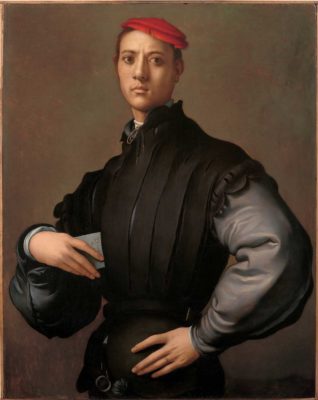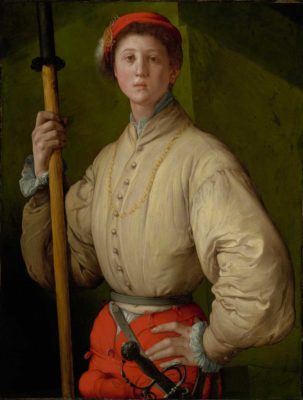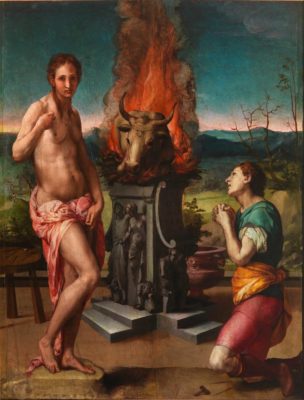
“Miraculous Encounters: Pontormo from Drawing to Painting”
Sure, a mighty retrospective spilling into adjacent galleries can be quite a treat, but at times a few choice works are all that’s needed for an important exhibition; and that’s what we have now with Jacopo da Pontormo (1494-1557) and a small but elegant show that opened Tuesday at the J. Paul Getty Museum in Brentwood.

Pontormo’s reputation was, and probably still is, as a religious painter and portraitist. How much evidence does the viewer require in order to sample the very best of each genre? Well, exactly what’s on view here.
Despite the scholarly text in the catalog that accompanies the exhibition, there remain several ifs and maybes, but it’s (relatively) safe to say that Pontormo’s “Visitation,” “Portrait of a Halberdier,” and “Portrait of a Young Man in a Red Cap” were created between 1528 and 1530. This was in the period just after the expulsion of the Medici from Florence and somewhat before their return to power. Turbulent times, during which Pontormo kept a low profile.

For all that, the “Portrait of a Young Man in a Red Cap” is a stunning work, now making its debut in the United States. It should also be noted that, by way of Giorgio Vasari, whose “Lives of the Artists” is the essential resource, the true identity of the Halberdier remains uncertain. “In sum,” writes Bruce Edelstein, in what is a demanding and thorough essay, “the arguments by scholars in favor of one identification or the other ultimately come down to how one reads Vasari’s account of Pontormo’s oeuvre. Is the painting of Francesco Guardi around 1529-30, or is it a portrait of the young Duke of Florence, Cosimo I de Medici, in the autumn of 1537?” Most votes tend to favor Francesco Guardi, but you never know.
A clearer vision
In Europe, mostly, there are numerous important works by Pontormo, with “Joseph in Egypt,” “The Deposition from the Cross,” and the “Portrait of Maria Salviati” among them. But standing equal with any of them is the “Visitation,” a painting that “was virtually unknown until its rediscovery and publication by Carlo Gamba in 1904.”

Mary, pregnant with Jesus, is about to embrace Elizabeth, pregnant with John the Baptist. The future saint in Elizabeth’s womb was supposedly cleansed of original sin by the proximity of this encounter, but, alas, I always picture him as the victim of Salome’s whim, and his head delivered to her on a silver platter. But that, as they say, is a later chapter in the book.
The “Visitation” is actually a curious picture in that two other women stand behind Mary and Elizabeth and face us, the viewer. This creates a charged dynamic, that’s for sure, but who are these women? Well, presumably they are attendants or chaperones, but another intriguing notion is that, rotated 90 degrees, they are also Mary and Elizabeth. The main reason this isn’t completely farfetched is because these attendants seem to resemble the two saintly ladies. Be that as it may, the colorful and billowing drapery that encloses this quartet might also suggest some kind of rare flower that’s just about to bloom.

An analysis of the restoration of the “Visitation” is presented by Daniele Rossi in the catalog, which may be of interest to those who are curious about how these 500-year-old masterpieces are conserved and preserved so that, when we see them, they look like they just stepped down from the easel. When the “Visitation” was cleaned, the head of a little donkey appeared on the far left, alluding, perhaps, to Mary and Joseph’s mode of transportation (today we have Mustangs and Broncos; they had donkeys). For that matter, husbands Joseph and Zechariah can also be discerned in the distance, perhaps chatting about sports or politics.
That’s all I’ll say about the highlights of this exhibition. As for Edelstein’s summation: “The three paintings examined here and their related drawings offer unique opportunities to consider Pontormo’s art when he had reached maturity and was considered by many to be the greatest living painter in Florence.” And furthermore, “The purpose of this exhibition is precisely to offer new opportunities to consider the hand of Pontormo from drawing to painting – the masterful hand of an extraordinary draftsman and painter that rendered each of his works unique masterpieces.”

Additionally, there’s Albrecht Dürer’s engraved “Four Naked Women” (loaned by ESMoA’s Brian and Eva Sweeney), which is believed to be one of the sources or inspirations for the “Visitation.” A precise definition of Dürer’s work is not given, and, as Giada Damen writes, “Most probably, neither Pontormo nor his contemporaries really understood the exact meaning of Dürer’s engraving.” However, one might guess that when unclothed young women are paired with human bones, as they are here, you can lay down money that the theme or moral has to do with vanity and the passage of time. After all, we learned about such things from the Getty’s last mega show, “The Renaissance Nude.”
Lastly, this show includes “Pygmalion and Galatea,” a painting by Pontormo’s pupil Bronzino, which served as a cover for the “Portrait of a Halberdier.” If paintings, reunited after many years, have the uncanny ability to resonate with one another when again in each other’s company, this is one show in which that could happen. Rare and precious, this is one of those small but focused gems that the Getty has so often conjured up for the delight of the few and the many.
Miraculous Encounters: Pontormo from Drawing to Painting is on view through April 28 at the J. Paul Getty Museum in the Getty Center, 1200 Getty Center Drive, Los Angeles. Related event: “Tradition and Innovation in Florentine Painting: Pontormo’s Visitation,” a discussion by Bruce Edelstein on Sat., Feb. 9, at 3 p.m. in the Getty’s Harold M. Williams Auditorium. Free; advance ticket required. Catalog, $40, edited by co-curators Bruce Edelstein and Davide Gasparotto. More at getty.edu. ER










